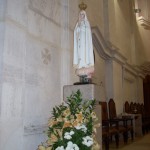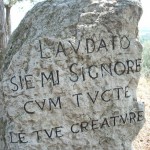At the cross her station keeping,
Stood the mournful Mother, weeping,
Close to Jesus to the last.
Through her heart, His sorrow sharing,
All His bitter anguish bearing,
Now at length the sword has passed . . .
Here it is the last Friday in Lent, and I have not yet participated in one of my favorite devotions, the Stations of the Cross. This pewchair pilgrimage, popularized by Francis of Assisi and his followers as a way of walking in the footsteps of Jesus’ Passion without having to make the arduous trip to the Holy Land, was the definitive landscape of my childhood Lents. We were marched across the street from school to the church every Friday, and got our exercise standing and kneeling, standing and kneeling as Father, accompanied by altar boys, progressed from station to station along the side aisles. Those altar boys, hormonally wired eighth graders, had the terrifying responsibility of reading aloud the meditations associated with each station, and I regret to confess that the high point of each week was waiting to see how the appointed lad would deal with the Fourth Station–Jesus Meets His Sorrowful Mother–which required the proclamation of the immortal line, “Mary clutched Him to her bosom.” We looked for, and got, red faces and stammering. On one memorable occasion, we got “ba-ZOOM,” which brought everyone, Father included, to unseemly hysterics.
The unfortunate text aside, the Stations were deeply moving then. Francis’s prayer–We adore Thee, O Christ, and we bless Thee, because by Thy holy Cross Thou hast redeemed the world–repeated at every station has become my lifelong mantra, repeated daily in sorrow and in joy. Most moving of all, though, was the singing of the Stabat Mater, the 14th-century sequence that places us at the foot of the cross with Mary. We sang the English version, set to a chant melody with the rocking rhythm of a cradle or a keening woman, found in the St Gregory Hymnal of 1920–a copy of which sits open next to me now.
I wanted to center today’s reflection on the Stabat Mater itself, and how this 800-year-old musical prayer remains as moving today as it ever was. It’s an especially appropriate occasion, this Friday before good Friday, because until Pius XII made changes to the liturgical calendar, the Stabat Mater was the sequence for the Feast of the Seven Dolors of the Virgin Mary celebrated on this day. In addition to the plainsong version I loved as a child, there are settings from nearly every major composer from Palestrina to Part. In researching the text, however, I ran into a surprise that took me in a new direction.
The text of the Stabat Mater was long credited to Jacopone da Todi, but in an Italian literature class I started taking last week I learned that this attribution may not be supported. The Latin text may predate Jacopone. If he was involved it may have been as a popularizer, translating the Latin into the Umbrian vernacular, where the sequence took on a life of its own as a kind of traveling musical meditation sung by the bands of Flagellants who provided both penitential spirituality and entertainment as they roved from town square to town square. There are certainly stylistic similarities between the Stabat Mater and Donna di Paradiso (Lady of Paradise), one of Jacopone’s best-loved laudi, or hymns of praise written in dramatic dialogue.
But I got distracted reading Jacopone’s story. He had an amazing life, even looked at from this much distance. Born in the Umbrian hill town of Todi, Jacopone studied law at the University of Bologna (Italy’s, and arguably Europe’s, first institution of higher learning) and became a wealthy and well-respected legal practitioner who amused himself by writing ballads in the courtly style. When he was 32, life dragged Jacopone to the foot of the cross in a most dramatic way. His beloved wife was killed during a banquet at their home, when the floor under the dais where they were sitting collapsed. Preparing her body for burial, Jacopone was shaken to see that under her luxurious gown his devout wife has secretly worn a hairshirt. Believing this to be a judgment on his own sins and lack of piety, Jacopone abandoned his worldly life and became a kind of holy fool, preaching penitence in the streets. He was eventually welcomed as a Franciscan friar, choosing to side with the Spirituals, who maintained a strict observance of Francis’s rule. Jacopone turned his poetic and dramatic powers to street sermons in rhyme and dialogue, the forerunners of Italian religious drama.
Jacopone’s choice to side with the Spirituals wasn’t just religious. It had political implications, as all religious choices did in that time (and in ours). It put him in conflict with another man associated with Todi, Pope Boniface VIII. As a young boy, Benedetto Gaetano had been schooled in diplomacy, assisting a relative who had a leadership position in Todi. He climbed the twin ladders of secular and ecclesiastical power quickly and avidly, at first promoting the election of Celestine V–The Pope Who Quit, as Jon M. Sweeney calls him in a recent book–and then facilitating Celestine’s abdication and his own election to succeed him. Celestine had taken the part of the strict-observance Franciscans, but Boniface VIII threw his support to the more liberal interpreters. This earned him Jacopone’s religious and secular wrath. Jacopone wrote poetic attacks on Boniface, calling for him to step down, and sided with the pope’s political adversaries, the powerful Colonna family. Boniface, whose lust for power and wealth caused Dante to place him in the eighth circle of the Inferno even before his death, didn’t take insurrection lightly. He excommunicated Jacopone and had him thrown into prison in 1298. When Boniface declared the first-ever Jubilee Year in 1300–a move even his supporters recognized as an attempt to fill the Vatican coffers with pilgrims’ gold–he pardoned all prisoners . . . all but Jacopone.
Boniface, too, for all his pride, was dragged to the foot of the cross. In 1303, the Colonnas led an army to capture Boniface, who had angered nobility and kings across Europe by issuing the bull Unam sanctam declaring the pope’s authority to be sovereign everywhere. He was imprisoned, beaten, and nearly executed, but died (as wikipedia puts it) “of kidney stones and humiliation” on October 11. Upon the pope’s death, Jacopone was freed from prison. He retired to a hill town near Todi, and died in 1306.
The Two Guys from Todi, it seems to me, make a good diptych of a reflection for this Friday before Good Friday. Dante aside, we place others in heaven or hell at our peril, and most of us are admixtures of pride and humility, sin and grace. Jacopone, for all his lyrical skills and saintly qualities, must have been a pain in the culo if you crossed him, and history has come out on the side of the more liberal interpretation of Francis’s rule. And Pope Boniface VIII may have sincerely believed he was defending the patrimony of the Church against equally proud and avaricious nobles. He was Giotto’s patron, and I’m willing to cut him a lot of slack based on that alone.
In any case, these intertwined stories remind us that the struggle to live in both the Church and the world is much older than our own times, and that no matter who we are, we too will be dragged to the foot of the cross. When we find ourselves there, let us stand with Mary and share as she did in the suffering that alone will set us free.
Thou, my Savior’s cross who bearest,
Thou, thy Son’s rebuke who sharest,
Let me share them both with thee.
In the Passion of my Maker
Be my sinful soul partaker,
Weep till death and weep with thee.
Mine with thee be that sad station,
There to watch the great Salvation
Wrought upon th’ atoning Tree.
I’ll be heading for Stations of the Cross tonight.











